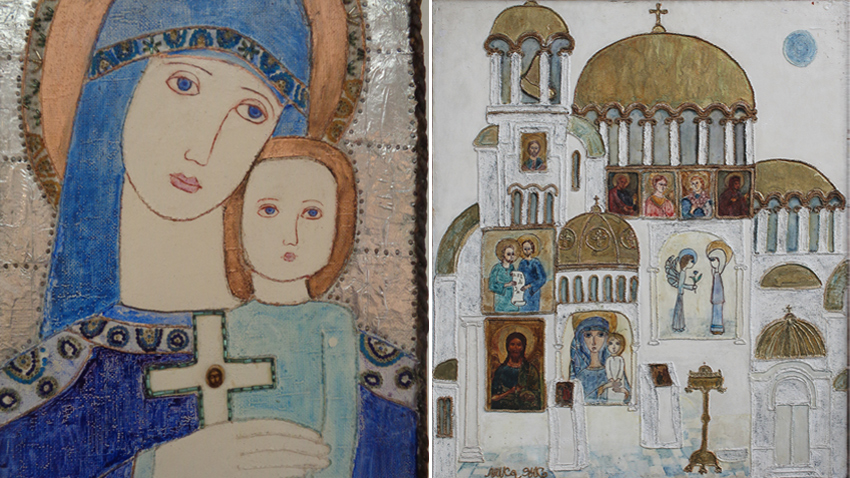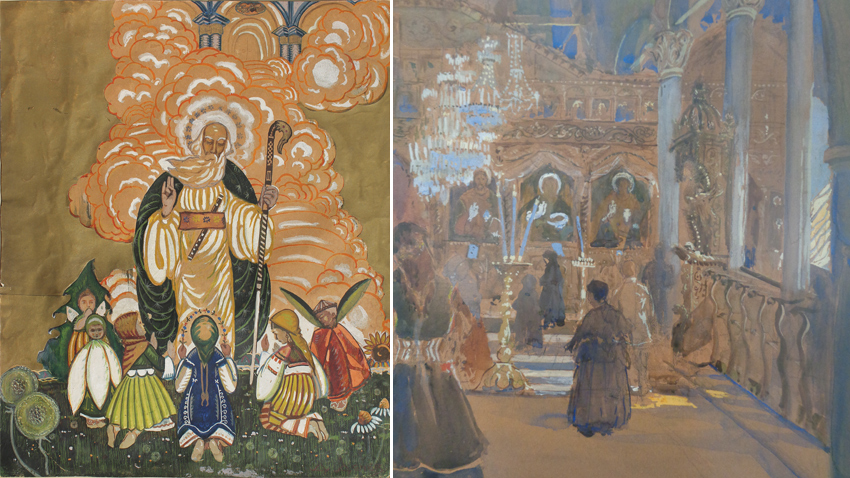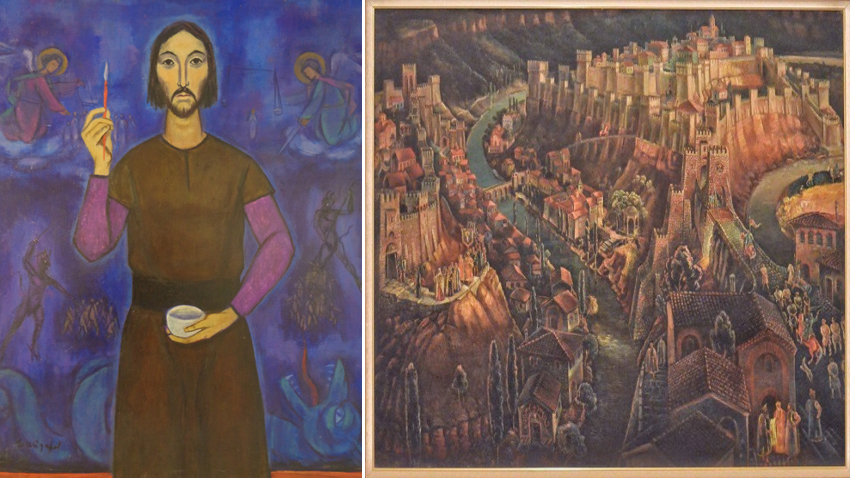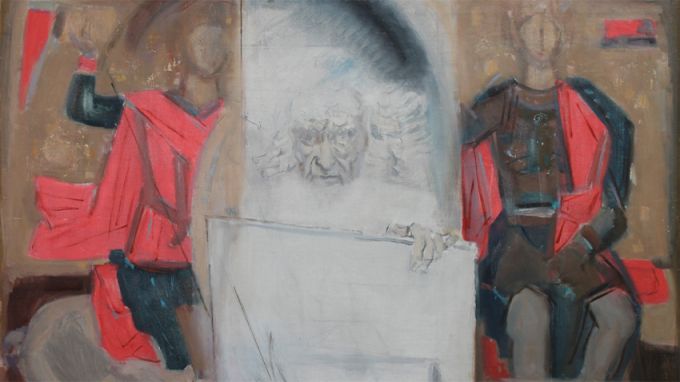An exhibition entitled “The icon, symbol and image in modern Bulgarian art” is exhibited at the Sofia City Art Gallery. It will last until February 4. The exhibition is dedicated to the icon and its impact on secular art. More than 100 works grouped into several thematic sections were presented during this exhibition.
“For almost a year and a half I have been interested in the subject linked to the presence of the icon in contemporary art, or rather in modern art and secular works,” the curator of the Lyuben Domozetski exhibition. I’m looking for authors who started presenting icons in one way or another after Bulgaria’s liberation from Ottoman rule. Some icons are part of the interior of buildings, others are part of a landscape and still others are part of a given ritual. Some authors present the icon as the starting point for new images, typical of the 1920s, when they were extremely popular in Bulgarian secular art.
 The icons in this exhibition were created between 1878 (liberation from Ottoman rule) and 1989 (beginning of the transition to democracy). To what extent were the authors of these icons, who worked after the liberation of Bulgaria, influenced by the artists of the Middle Ages and the Renaissance?
The icons in this exhibition were created between 1878 (liberation from Ottoman rule) and 1989 (beginning of the transition to democracy). To what extent were the authors of these icons, who worked after the liberation of Bulgaria, influenced by the artists of the Middle Ages and the Renaissance?
“Interest in medieval art increased during certain periods. If we look at some of the first foreign authors who came to Bulgaria, we will find that they were very impressed by the antiquities they found. Everything was important to them, from the smallest detail of the colorful folk costumes of the local people to the smallest detail of the design of a Balkan Christian temple, including the icons placed on the walls of the church and the icons of altar rails.
 Lyuben Domozetski gave the example of one of the most brilliant artists of post-liberation Bulgaria, Czech artist Ivan Mrkvicka, who depicted in one of his paintings a church service with lamb .. Mrkvicka paid attention to the smallest details, from the elements of the national folk costume and the two lit candles placed on the lamb’s head to the interior decoration. An icon is visible behind the priest. In fact, this icon is present in the church space and is part of a set representing the interior of the church and the religious life of the Balkan nations.
Lyuben Domozetski gave the example of one of the most brilliant artists of post-liberation Bulgaria, Czech artist Ivan Mrkvicka, who depicted in one of his paintings a church service with lamb .. Mrkvicka paid attention to the smallest details, from the elements of the national folk costume and the two lit candles placed on the lamb’s head to the interior decoration. An icon is visible behind the priest. In fact, this icon is present in the church space and is part of a set representing the interior of the church and the religious life of the Balkan nations.
Also present at the exhibition are the works of Austrian artist Joseph Oberbauer and Czech artist Joseph Peter, who painted life in ancient Sofia.
 “We can imagine what Sofia looked like at the end of the 19th century shortly after the liberation of Bulgaria from Ottoman rule. There were few modern buildings, the streets were full of mud and no asphalt was laid on them. These are mainly cramped one-story buildings. However, some old buildings from different eras have been preserved such as the Sainte-Sophie church, the Saint-Georges rotunda, etc. Foreign authors were also impressed by this different Balkan reality.
“We can imagine what Sofia looked like at the end of the 19th century shortly after the liberation of Bulgaria from Ottoman rule. There were few modern buildings, the streets were full of mud and no asphalt was laid on them. These are mainly cramped one-story buildings. However, some old buildings from different eras have been preserved such as the Sainte-Sophie church, the Saint-Georges rotunda, etc. Foreign authors were also impressed by this different Balkan reality.
Icons are also presented in another context, when presenting paintings of a historical nature related to the medieval period and the national renaissance and the theme related to icon painters. Artists are very enthusiastic about these subjects, emphasizes Lyuben Domozetski. The icon, for example, is present in a composition linked to the second Bulgarian kingdom and its capital Tarnovgrad. Either he watches over the head of the mother-to-be, or the hero of the national renaissance is compared to a warrior on horseback who defeats evil incarnated in a dragon.
 After Bulgaria’s liberation from Ottoman rule, Bulgarian religious art followed the academic line, adds art critic Domozetski. It is interesting to note that in the 1920s, secular art turned to the aesthetics of the medieval icon – the number of contemporary authors interested in Byzantine art and icon painting, frescoes and manuscripts increased. This was influenced by the quest to modernize Bulgarian art through the search for a national appearance.. According to curator Domozetski, this is clearly seen in the works of famous Bulgarian artists Ivan Milev and Ivan Penkov, who worked in the 1920s. Speaking about the influence of iconography on secular art, we should not forgetting the influence of artistic language – the inclusion of halos, gold, linear and flatter decorative representations of form. Of course, all this has a deeper meaning and this iconic language is not accidental and due to the whim of the icon painter. These typical specificities of medieval art sometimes impress the authorsunderlines Lyuben Domozetski.
After Bulgaria’s liberation from Ottoman rule, Bulgarian religious art followed the academic line, adds art critic Domozetski. It is interesting to note that in the 1920s, secular art turned to the aesthetics of the medieval icon – the number of contemporary authors interested in Byzantine art and icon painting, frescoes and manuscripts increased. This was influenced by the quest to modernize Bulgarian art through the search for a national appearance.. According to curator Domozetski, this is clearly seen in the works of famous Bulgarian artists Ivan Milev and Ivan Penkov, who worked in the 1920s. Speaking about the influence of iconography on secular art, we should not forgetting the influence of artistic language – the inclusion of halos, gold, linear and flatter decorative representations of form. Of course, all this has a deeper meaning and this iconic language is not accidental and due to the whim of the icon painter. These typical specificities of medieval art sometimes impress the authorsunderlines Lyuben Domozetski.
English version: Kostadin Atanassov
Photos: Veneta Pavlova, sghg.bg


